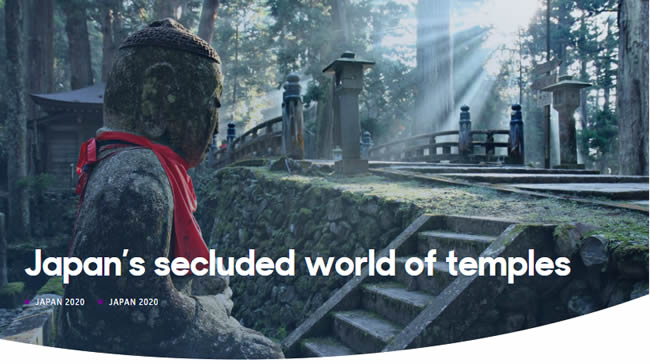先日から「Japan’s secluded world of temples – 日本の人里離れた寺の世界」を読んでいます。

・「日本の人里離れた寺の世界」(1)
Worshipping the natural world
自然界を崇拝するToday, Koya-san is part of the sacred pilgrimage routes known as the Kumano Kodo, whose towering cedar and cypress forests, crashing waterfalls and temple-studded peaks appear to be suspended among the clouds in certain places.
今日、高野山は熊野古道の名で知られる巡礼ルートの一部となっており、杉とヒノキのそびえる森や滝の音、寺院が点在する峰々が、雲の間に浮かんでいるように見える。
pilgrimage「巡礼、聖地巡拝、(特別な場所への)長旅、(理想を求める)遍歴」。
This 307km network of moss-covered stones and earthen trails, which connect the three great Kumano shrines to Koya-san, attracts roughly 15 million visitors a year and reflects the ancient Japanese belief of worshipping nature.
この307キロに渡る苔むした土の道は、荘厳な3つの熊野神社と高野山を結び、年間に約1500万人が訪れる、古代日本人の自然崇拝を今に反映する場所だ。
In the Japanese religion of Shintoism, forests and rocks can be inhabited by the spirits of gods (kami) and every element of nature is considered divine.
日本の宗教・神道においては、森や岩々は神々の住みかであり、全ての自然は神に通ずると考えられていた。
divine「神の、神聖な、宗教的な、神のような、こうごうしい、非凡な、すばらしい」。
Of the 117 temples scattered throughout Koya-san, some 50 of which serve as shukubo inns where guests can spend the night, meditate and commune with monks.
117の寺々が高野山に散在し、そのうち50ほどは宿坊として宿泊可能で、瞑想や僧侶との歓談ができる。
commune with~「~歓談する」。
And more than 1,200 years after Kukai (posthumously known as Kobo Daishi) first ventured into Koya-san’s secluded slopes, his spirit is believed to reside here in eternal meditation.
そして空海(死後は弘法大師として知られる)が高野山に足を踏み入れてから1200年以上経つ今も、彼の魂はこの地にあり、永遠の瞑想行に入っていると信じられている。
posthumously「死後に、遺作として」。
reside「住む、住まう、駐在する、存する、属する、帰する」。
人々のために瞑想行を現在も行っているという空海さん、彼の居住する場所には、今も毎日きちんと食事が運ばれているそうです。
彼はかなりの超能力者だったのでは、という話も聞くので、1200年以上(精霊として)生き続けているというのも、もしかしたら本当かもとムー民としては思っています。
理由は単純明快!「少ないコストでしっかり楽しく学べるから」。
私自身の経験(高機能でビックリ)をびっしり書いていますので、良かったら読んでみてください。
下のバナーからどうぞ!






